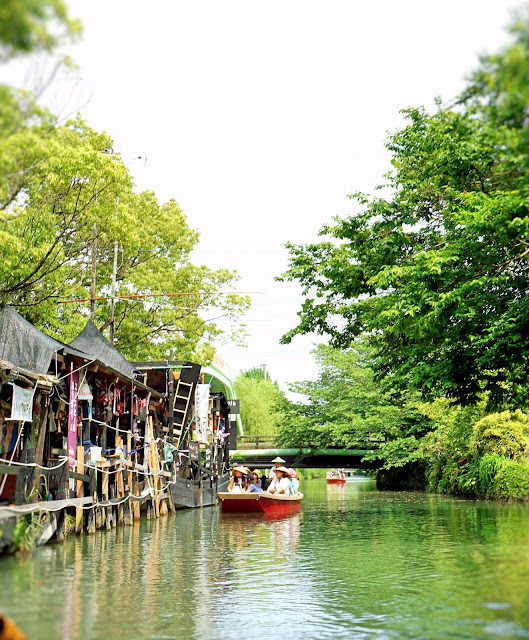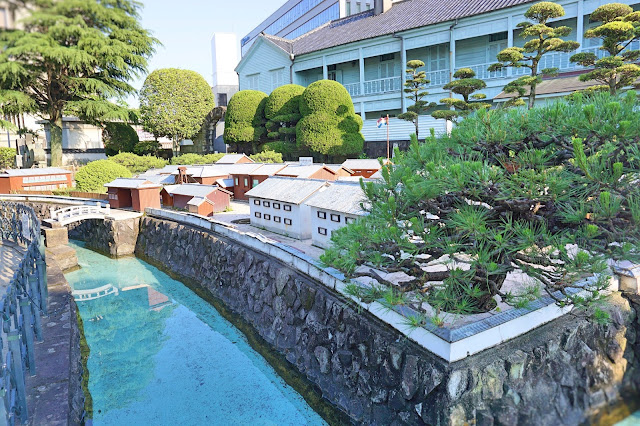Day 5: Yutoku Inari Shrine --> Yanagawa Canal Boat Ride (柳川川下り) --> Tosu Premium Outlet (鳥栖プレミアム・アウトレット) --> Hotel
Once we were done at the Yutoku Inari Shrine, our driver proceeded to bring us for a tofu onsen-hotpot meal: . According to him, the tofu was homemade and said to be extremely good for the skin.
When we got there, it was very obvious that we were the only group of tourists around. The rest of the restaurant was filled with local Japanese (especially ladies!). I guess this is one of those "you won't know unless you're a local" places. I couldn't even find a proper English translation of the name of the place. It's Japanese website says Saga-Hirakawaya, so I'm just going with that.
The proprietor of the shop was very lovely and took the time to try to explain to us (with some translation help and sign language) how we were supposed to enjoy the tofu. During the course of our meal, she also kept topping up our tofu! So much so we had to stop her as we were just too full!
Unfortunately, my family was divided on this meal. I like my tofu and I loved the taste of the homemade tofu in the hotpot! In fact, it was even good on its own with the accompanying sauce and sesame seeds. However, my dad's (who's not a tofu person) barely stomached any. He just scooped up all the vegetables in the hotpot. However, we all agreed that their home-grown green tea was one of the best! Immediately after our meal, Mom bought a bag of the green tea leaves.
Once we were done with lunch, we proceeded to the next item on our itinerary: the Yanagawa Canal boat ride.
Yanagawa is primarily known for its water canals. It was originally a farming village and the canals were built initially for the purpose of irrigation. Later, the canals evolved to also become a source of water transportation. Today, these canals continue to be a source of income for the people in the form of tourist revenue.
There are several companies offering the boat rides (also known as punting). All of them also provide free shuttle bus services from the nearest train stations. Just google and you should be able to find and compares their prices and services. Some of these companies have also collaborated with the cafes and restaurants along the venue to offer complimentary drinks or discounted meals. So just be mindful about what you're paying for.
Since ours was already pre-arranged, I didn't really bother to check out which company it was. Instead, I just happily followed to put on the hat and board the sampan like vessel.
I've got to say this. THANK GOD for the hat! The boat ride, while enjoyable, was more than an hour in the blistering afternoon sun! If not for that triangular straw cap, I think I would have been thoroughly sun burnt!
This was our punter. Well, I assume that's what they'll be called (punting --> punter). I didn't catch his name since he was conversing with everyone else in a thick Japanese accent. From what I understood, most of the punters are older. The younger generation isn't apparently too interested in punting anymore. And unfortunately, most of the older punters aren't conversant in any other language.
A pity since I could tell that ours was a humorous dude. Everyone else on the boat kept laughing at his story-telling and jokes. I would have loved to find out what they were all laughing about. On a few occasions, he even broke out into Japanese songs. While I didn't understand anything of what was being sung, our punter had a lovely voice reminiscent of folk singing. Our guide was kind of useless by now, he didn't really bother to translate much of what was said even when I asked.
The ride itself was quite scenic. There were several lovely photo points, be it of buildings, flora and fauna. There were even a couple of mini altars/shrines built along the route. One of them even had Kirin beer cans as offerings! The trouble though was because you were on a moving vessel (and it moves surprisingly quickly!) you need to calculate your angles pretty darn quick.
Another obstacle, you won't be the only person on board that vessel who'll want pictures. I've lost count of the number of times I had to shift because of someone's raised phone or camera. So if photos are what you're after, you should grab seats at the front of the boat to avoid those photo-bombs. Or else, move to the rear.
The next exciting bit about the ride was the amount of ducking we had to do. And by that I mean whenever we approached any of the low bridges or tight tunnels.
These boat punters have amazing skills and stamina. No matter how tight the tunnel would look, the boats were all able to pass through unscratched. When we approached the first tunnel, my mom actually looked bewildered when our punter started moving towards it. She even grabbed my arm and wondered if we were able to get through safely!
Very quickly, we came to learn to duck each time our punter started his weird song-song English of "Put your head down". English because it was obviously meant for us who didn't understand a single word of Japanese. Weird because he was definitely not a speaker of the language and did so in a heavily accented sing-song voice. Nevertheless, it had a fun effect and by the fourth or fifth one, even mom was laughingly ducking her head along with everyone else.
And I'm super amazed that these punters had the muscles and stamina to keep bending up and down, all the while pushing a boat full of people for more than an hour! Apparently, some even perform acrobatic jumps across those bridges! They must be damn fit!
Mid-way through the ride, our punter "drove" us past this shack selling snacks! I was seriously amazed that even soft serve was offered! Actually contemplated but since I was still quite full from all the earlier tofu, I decided to forgo the ice-cream. It would otherwise have been heavenly in that heat!
If I'm not mistaken, there are 2 options for how long you want your boat ride to be. Our tour agent had apparently arranged for the longer option without us realising it. If you're with young children or elderly parents, you may wish to consider the shorter option as they may get bored. Afterall, there's only so much interest buildings and trees can offer for some.
By the 45th minute mark, mom kept asking when the ride was going to end. On the other hand, dad got excited seeing a group of photographers on the bridge (picture above). Apparently he had thought that they were the tourist-commercial sort and were taking pictures for sale later. He actually kept waving his hands around because otherwise there was nothing much else to do...
The minute we were done with the boat ride, my parents hurried into a restaurant for their complimentary drinks. Not because they wanted the freebie, but more because they were too hot from the sun beating down on them. Mom also desperately needed the loo.
Actually, if not for the earlier meal, I would also have contemplated sharing a unagi don with my parents. Apart from the canal rides, Yanagawa is also famous for their unagi rice bowls! While seated in the restaurant, the smells wafting from all those unagi sets were just wonderful!
Heh. To be honest, I might have eventually caved if it wasn't because we had to catch the next shuttle out.
By late afternoon, we finally reached Tosu Premium Outlet, the trip's first major shopping stop. Whenever I bring my parents to Japan, I always make sure to arrange to drop by an outlet mall for them. They love the discounts from some of the major brands that are on offer. In fact, I always have to inform them beforehand what brands are available so that they can anticipate what to buy.
While my mom always grumbles about my shopping in Singapore, she has never once complained whenever I shop at these outlet malls with them. Heh. Another reason why they're always in my Japan itineraries with my parents.
We bought quite a lot in the short time we were there! I had a lovely Godiva Special Anniversary drink while I was there and bought tons of Godiva chocolates back for friends. Also bought 2 Coach bags (the 2 at the bottom corner right in picture below) for myself while mom got another 2 for herself. I also got quite a bit of clothes from Gap while dad (who hates shopping) bought 2 pairs of Hush Puppies shoes.
I swear. We were there for less than 2 hours.
What contributed to the speed at which we shopped was mainly because I had already printed out a map and studied where each brand was located in the mall. So in essence, we already knew which shops we wanted to go and just aimed straight for those.
I could have still continued for sure, if not because mom started to complain that we were going to miss our dinner time...
Tourist Information
Saga Hirakawaya (佐嘉平川屋)
Website: http://www.saga-hirakawaya.jp/
Yanagawa Canal Boat Ride
Address: Takahata, Yanagawa 8320065
Local address: 〒832-0065高畑
There are many companies offering the canal rides. Please google and check for what suits you.
Tosu Premium Outlet (鳥栖プレミアム・アウトレット)
Address: 8-1 Yayoigaoka, Tosu 841-0005
Local address: 〒841-0005弥生が丘8-1
DID: +81 942-87-7370
Operating hours: 10 am to 8 pm








































































